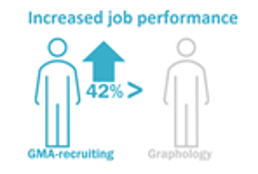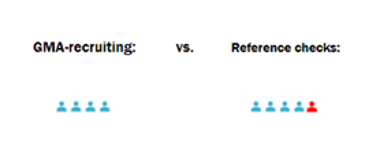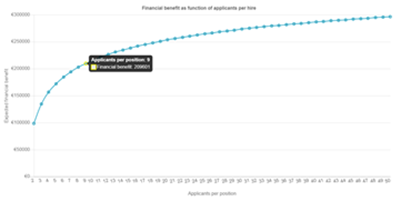Master Recruitment Decision Tool
Helping to argue for the use of tests in recruitment.
This article is a supplement to our Master Recruitment Decision Tool (RDT) which we have linked to at the end of this article. We recommend that you read the article before using the tool.
Link to the tool can be found of the end of the article.
We build RDT with the purpose of narrowing the gap between research and practice. Showing the financial consequences of various recruitment methods, the practical value of different recruitment methods in various recruitment scenarios, and the financial effect of changing key aspects of your recruitment setup. RDT is built around General Mental Ability (GMA) recruiting and has two parts; one is a comparison part that showcase the strength and financial benefit of switching from one recruitment method to GMA-recruiting, the other part is about giving valuable insights into key aspects of GMA-recruiting.
GMA-tests have in research long been regarded as the single recruitment method with the highest consistent ability to predict job performance (Schmidt and Hunter, 1998; Le & Schmidt, 2006; Schmidt, Shaffer & Oh, 2008; Schmidt, Oh & Shaffer, 2016). A finding that has been replicated in different job positions and across numerous countries (Salgado et al., 2003).
It has therefore been an interest of ours for a long time to develop a tool that can showcase the meaning and importance of this research. A tool that can transform the research into business language and supporting decision making when choosing recruitment methods.
The usefulness and value of recruitment methods are typically explained in a statistically language, not a financial language unlike many other sectors of an organization. That limits the comparability of recruitment method decisions with other financial decisions in an organization. It is therefore important for HR-professionals to transform our results and knowledge about recruitment methods into financial language.
The RDT tool does exactly this and empowers HR-professionals in the dialogue with other sectors of an organization, by supporting HR in speaking the Financial tongue and presenting financial arguments that can be used when arguing for the use of GMA tests in recruitment.
RDT is based on Utility Analysis, an umbrella term for a group of mathematical models with roots in mathematics, economics, and psychology (Sturman, 2003).
What is a utility analysis?
The purpose of utility analysis is to quantify the usefulness and relative value of different options on which to base decision making. Information that can help organizational decision makers choose among alternatives by knowing the relative value of the different options (Cabrera & Raju, 2001).
Utility analysis is not only useful for quantifying the financial benefit of using one method over the other. It can also be used to gather information about the difference in expected job performance of people hired using different hiring methods.
RDT is based on a utility model called Brogden-Cronbach-Gleser, probably the most popular utility model (Sturman, 2003). The math behind the model is explained in detail in the appendix of RDT.
The mechanics of Master Recruitment Decision Tool
There are a few important concepts in utility analysis that are important to grasp, to understand how RDT works, and how we have developed the tool.
Utility analysis is built on criterion validity. In short, criterion validity tells us how well we can predict job performance by using a particular recruitment method. The criterion validity of different assessment methods is incorporated into the RDT using values from the meta-study by Schmidt, Oh & Shaffer (2016). Criterion validity has for long been the standard way of comparing the usefulness of different recruitment methods in research. However, criterion validity can be difficult and too abstract to interpret in practice. A criterion validity of 0.50 does not mean a recruitment method can predict 50 % of job performance. And a method with a criterion validity of 0.60 do not predict double as much job performance as a method with a criterion validity of 0.30 but 4 times the amount. But when transformed by a tool like RDT criterion validity can help provide a lot of information.
Another important part of utility analysis is variability in job performance. Variability is the difference between high performers and low performers. Research show that almost all types of jobs regardless of their complexity have some degree of variability in job performance (Hunter, Schmidt & Judiesch, 1990).
One of the most important findings in this type of research is the average difference in economical contribution by high and low performers across professions. We use the most conservative estimates for job variability to make sure that our tool is useful across professions. This means that the results for many professions might be a lower bound.
The third important part of utility analysis is the selection ratio, the number of suitable applicants per hire. The more candidates we can choose from, the more important the recruitment method becomes. If we have a recruitment method with sky high criterion validity but only one applicant – then the validity of the method is irrelevant, because we would be forced to hire that person no matter what, as the alternative is no employee at all. On the other hand, if we have a lot of applicants then the validity of the method becomes very important, as the difference in future job performance from one candidate to another becomes essential.
Master Recruitment Decision Tool in practice
Master International’s RDT returns several outputs which are all shown due to their relevance and usefulness in communicating recruitment benefits. The tool returns:
The expected financial benefit, which is the difference between GMA-recruiting and the selected comparison recruitment method in expected total financial benefit due to job performance by those hired their duration at the organization. RDT also returns the expected financial benefit per new hire and the yearly benefit.
RDT also returns expected job performance which is the expected percentage difference in job performance by the average hire of the two methods. This will show how important choosing one assessment method over another, can have on the chance of hiring high performers.

The last metric is number needed to hire which is the number of people you would need to hire with the alternative method, to get the same level of job performance as with GMA-recruiting.

The reason RDT both has financial metrics (Expected financial benefit – total, yearly, and per hire) and operational metrics (Difference in Job Performance and Number Needed to Hire) is that the metrics can add value in different situations.
The financial metrics are commonly used when communicating with people outside of HR as an aide in decision making. Operational metrics can be very useful when making strategical choices internally in HR.
Real life recruitment involves chance, and you can be both unlucky and lucky with your recruiting regardless of how good your recruitment method is. RDT offers a large simulation of the recruitment scenario you have chosen where the randomness of real life recruiting in included.
RDT also offers an opt-in analysis called applicant analysis unlike the other metrics this is not a comparison analysis, but it visualizes and analyses the effect of changes to your selected applicant-per-hire ratio. This analysis is advanced and are targeted HR-professionals helping creating cost-benefit analysis on whether to invest in attracting more applicants.
How to present and use the tool in practice
The most important purpose of this tool is to show that there are real financial benefits and consequences of your choice of recruitment method. Even methods that do not differ greatly in criterion validity can show completely different results when they are applied to a recruitment scenario.
It is our hope that RDT can be used to explain the consequences and the importance of choosing the right recruitment method to decision-makers and other people outside of HR. Before presenting results from RDT to decision-makers use some time to get familiar with the results and decide which outputs you need to show. It can be overwhelming to be presented with all the results at once, and maybe only some are relevant in your situation.
Link to the tool
References
Cabrera, E.F. and Raju, N.S. (2001), Utility Analysis: Current Trends and Future Directions. International Journal of Selection and Assessment, 9: 92-102. https://doi.org/10.1111/1468-2389.00166
Le, H. and Schmidt, F. (2006) Correcting for Indirect range restriction in meta-analysis: Testing a new meta-analytic procedure. Psychological Methods, Volume 11: 416–438. https://psycnet.apa.org/doi/10.1037/1082-989X.11.4.416
Hunter, John & Schmidt, Frank & Judiesch, Michael. (1990). Individual differences in output as a function of job complexity. Journal of Applied Psychology. 75. 28-42. https://doi.org/10.1037/0021-9010.75.1.28
Salgado, J.F., Anderson, N., Moscoso, S., Bertua, C., and De Fruyt, F. (2003) International Validity Generalization of GMA and Cognitive Abilities: A European Community Meta‐Analysis. Personnel Psychology, Volume 56: 573-605. https://doi.org/10.1111/j.1744-6570.2003.tb00751.x
Schmidt, F. and Hunter, J. (1998) The Validity and Utility of Selection Methods in Personnel Psychology. Psychological Bulletin, Volume 124(2): 262-274. https://doi.org/10.1037/0033-2909.124.2.262
Schmidt, F. L., Oh, I. S., and Shaffer, J. A. (2016) Validity and utility of Selection Methods in Personnel Psychology: Practical and theoretical implications of 100 years of research findings. Working paper
Schmidt, F. L., Shaffer, J. A., and Oh, I.-S. (2008) Increased accuracy of range restriction corrections: Implications for the role of personality and general mental ability in job and training performance. Personnel Psychology, Volume 61(4): 827-868. https://doi.org/10.1111/j.1744-6570.2008.00132.x
Sturman, C, M., (2003) Utility Analysis: Definition and History. The Cornell Hotel and Restaurant Administration Quarterly, Volume 44(2): 109-116, https://doi.org/10.1016/S0010-8804(03)90024





